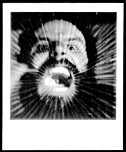|

Comment
on this story
What:
Innovation/ Imagination show
Where:
The Knoxville Museum of Art, 1050 World's Fair Park
When:
Aug. 16 through Nov. 17, 2002. Call 525-6101 for information
|
|

Fifty years of Polaroid images inspired by an eager little girl
by Heather Joyner
A medium invented in the 1940s by a vacationing Edwin H. Land (after his daughter expressed her wish to see her portrait sooner rather than later), instant photography was an instant hit. And it remains popular despite the digital revolution. Beyond bypassing the need for a darkroom or gauging correct exposure prior to whipping out one's Hasselblad, its medium is part of its message—meaning that it generally lends its subjects a certain immediacy via its very nature. Just as a movie on television has a different flavor than it has on the big screen, a Polaroid print often distinguishes itself with unusual color saturation and/or frayed emulsion edges that lend it a character all its own.
These days, digital cameras have made Chinese-assembled Polaroid equipment costing $25 a pop seem pretty lame. Plastic cameras gobbling up smelly and expensive film are no longer the only photographic means by which we can see our beloved pictures right away. And yet the Polaroid Corporation still claims annual sales of around $2 billion! Digital-imaging ware (hard and soft) and sunglasses factor into Polaroid's gross as well as cameras and film, but it's nevertheless an impressive figure. Furthermore, the corporation that initially hired Ansel Adams to test its stuff continues to expand its collection of approximately 23,000 prints by giving selected artists cameras to play with. The almost 100 images soon to be displayed at the KMA are impressive, too. In fact, I'm jumping the gun calendar-wise for a change, and viewers will have to wait a week after this column comes out to see what I'm talking about. That wait is well worth it.
So, what's the big deal about making Polaroid images? Sure, it's fun to activate a pod of chemicals that spread themselves over a glossy surface revealed when we ceremoniously peel off a protective covering. It's like the lovely crack!—then fizz, of a can of soda being opened on a sultry summer day. What's more, you can rub the photo on your ass to speed up the almost magical process of an image gradually appearing. But we're talking artists—not Aunt Mildred; why choose the Polaroid process over another? The KMA's upcoming "Innovation/Imagination" show provides us some clues.
Filling two large gallery spaces are works by photographers William Wegman, Judy Dater, Robert Mapplethorpe (gasp!), David Hockney, Carrie Mae Weems and Robert Frank, among others. They reflect a panoply of celebrated talent, and the range of perspectives is thrilling. There's a luscious expanse of blackness surrounding Wegman's weimaraner in "Fay in a Box" (1987), whereas Hockney's 1982 assemblage featuring "Imogen and Hermiane" is one of his signature grids of Polaroids creating a single image. A differing grid of small prints by Silvia Taccani has a kaleidoscopic beauty, and shots by Mapplethorpe, Paul Caponigro, Barbara Kasten and Fazal Sheikh are simply gorgeous. Some works dazzle, and some shock (like Jeffrey Silverstone's "Orpheus, Silent Fires," Masahisa Fukase's "The Game," Gottfried Helnwein's "Self-Portrait" and a pair of untitled prints by Nancy Burson). Nudes hang alongside industrial landscapes and dramatic scenarios, and decades' values are examined through subject matter.
Largely absent are the expected manipulations in which emulsion is rubbed or otherwise altered during the development process. Instead, we get a glimpse of far more sophisticated methods (such as Rick Hock's approach to his textured "Snake Script" construction in which two dozen prints' Mylar coverings have been removed altogether). The whole melange makes us want to dash home and start messing with instant film, just to see what it can do.
William Christenberry speaks of freeing his intuition through the Polaroid process, saying he takes risks he'd not take if he were unable to view his images immediately. Sean Kernan explains that instant film "introduces aspects of sketching, erasing, manifesting and then refining." Both photographers exemplify technical as well as artistic mastery, following in Adams' footsteps.
Land once commented that "the beauty of pictures by Adams played a striking inspirational role not so much in leading us to make beautiful pictures as to drive us toward 'beautiful' science as the basis for ultimate beauty in pictures." We see an example of Adams' research efforts as well as his aesthetic sensibility when looking at a collage of sorts, incorporating documentation of exposure experiments with actual photographs. It provides an interesting counterpoint to images by Andy Warhol and like-minded artists who viewed Polaroid prints as late 20th Century "ready-mades" reflecting a fast-paced culture. Because they're instantaneous and therefore "indulgent," such photographs project a casual and amateur feel that is at the heart of Warhol's grand deception.
Other artists use the Polaroid format's physical limitations to produce assembled compositions suggesting multiplicity in terms of meaning. Whatever an artist's motives, Polaroid prints seem capable of embodying his or her desired vision—which explains the variety found in an exhibit long overdue in Knoxville. This one's a humdinger, and I think Land would be proud.

August 8, 2002 * Vol. 12, No. 32
© 2002 Metro Pulse
|